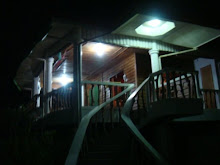
The Oblation Run, UPLB( photo from photobucket.com)

The two pictures above are the "OBLATION RUN", an annual activity that had been attracting nationwide visitors and the press in UP. There was no Oblation Run during my college years. The photo is from the web, by photobucket.com (pinoyblogosphere).
The first photo was in the Diliman campus. The second photo was the run in the Los Banos Campus,in 2004. Here's a video of the 2011 Run.
* Historical Notes about the Oblation Run from Wikipedia
The Oblation Run is an annual tradition of the members of the Alpha Phi Omega, one of the prominent U.P. fraternities. Members of the fraternity run around the campus naked (a concept known as streaking) to protest their sentiments about a current political or economic situation. The run started in 1977 to protest the banning of the movie, “Hubad na Bayani,” which depicted human rights abuses in the martial law era.
Contrary to popular belief, neophytes are forbidden to run. "All those who run are full-fledged members who have volunteered" are allowed to run, explains Ojie Santillan, the fraternity's Auxiliary Chancellor. "There is a misconception that the Oblation Run is something our neophytes have to undergo as part of their initiation. That’s not true. We never allow our applicants to join.(the Oblation Run)" Today, the Oblation Run is held on or about December 16th, in honor of the international founding of Alpha Phi Omega.
"The Great Centennial Run"
Exactly, on UP's 100th anniversary day, and in the “UP Oblation Run," 100 UP-based Alpha Phi Omega (APO) Fraternity and several UP alumni on June 18, at 11:00 a.m., ran naked along the University of the Philippines (UP) campus to commemorate the centennial anniversary. They sprinted from the Vinzon’s Hall and stopped at Palma Hall, for short photo opportunity. Jejomar Binay, alumnus and former prime chancellor of APO fraternity led the event. Runners called "Scholars of the People" carried placards, "Serve the People," to petition for the state subsidies to their education.
The History of the Sculpture from Wikpedia:

The idea for the Oblation was first conceived during presidency of Rafael Palma, who was the one to commission Tolentino to make the sculpture. Palma requested that the statue would be based on the second verse of Jose Rizal's Mi Ultimo Adios;
"In fields of battle, deliriously fighting,
Others give you their lives, without doubt, without regret;
Where there’s cypress, laurel or lily,
On a plank or open field, in combat or cruel martyrdom,
If the home or country asks, it's all the same--it matters not".
The concrete sculpture painted to look like bronze, measures 3.5 meters in height, symbolizing the 350 years of Spanish rule in the Philippines. The sculpture is replete with references of selfless dedication and service to the nation, and as Tolentino himself describes it;
"The completely nude figure of a young man with outstretched arms and open hands, with tilted head, closed eyes and parted lips murmuring a prayer, with breast forward in the act of offering himself, is my interpretation of that sublime stanza. It symbolizes all the unknown heroes who fell during the night. The statue stands on a rustic base, a stylized rugged shape of the Philippine archipelago, lined with big and small hard rocks, each of which represents an island. The “katakataka” (wonder plant) whose roots are tightly implanted on Philippine soil, is the link that binds the symbolized figure to the allegorical Philippine Group. “Katakataka” is really a wonder plant. It is called siempre vivo (always alive) in Spanish. A leaf or a piece of it thrown anywhere will sprout into a young plant. Hence, it symbolizes the deep-rooted patriotism in the heart of our heroes. Such patriotism continually and forever grows anywhere in the Philippines".

Originally, the statue was completely naked, but, as morality was prevailing at that time, it was modified by former U.P. President Jorge Bocobo with the addition of a fig leaf to cover the genitals. The sculpture was funded by the UP students of 1935-1936, and was presided by Potenciano Illusorio and Jose B. Laurel, Jr., presidents of the student council during the first and second semester respectively and was dedicated on March 1939 at the University's Manila campus where it stayed until February 1949, when the main administrative offices of the university moved to the new Diliman campus in Quezon City. The transfer of the Oblation to its new home served as the highlight of the move from Manila, which is historically referred to as the Exodus. The sculpture in front of the Quezon Hall at Diliman was installed facing west, purportedly a tribute to the American roots of the university. Today, that sculpture is only a bronze replica (which was recast from the original in Italy, in 1950, under the supervision of Tolentino himself) dedicated on UP's Golden Jubilee on November 29, 1958. The original sculpture is being kept at the Main Library (Gonzalez Hall), the former site of the UP College of Fine Arts, where Tolentino taught.
Several replicas of the Oblation were made for campuses of the University of the Philippines, some by national artist, Napoleon Abueva. 2005 national artist nominee Glenn Bautista,likewise, did his celebrated version of the Oblation in pen and ink as part of his school plates at the UP College of Fine Art under Professor Rebilion. The sculpture was registered at the Intellectual Property Office in the year 2004. Being the main symbol of the university, the Oblation is the centerpiece of many UP-related logos, like those of the Philippine Collegian and other student publications, the UP Cooperative, and the UP centennial emblem.



















